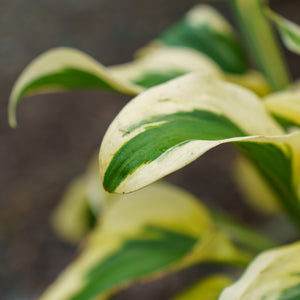The Hosta Guide
Hosta, often called plantain lilies, are shade-loving perennials celebrated for their lush foliage, striking textures, and easygoing nature. Whether grown for their cool blue hues, vibrant variegation, or dramatic size, hostas are foundational plants in woodland gardens, shady borders, and containers. With hundreds of cultivars available, gardeners can build entire landscapes based on color, leaf shape, and size.
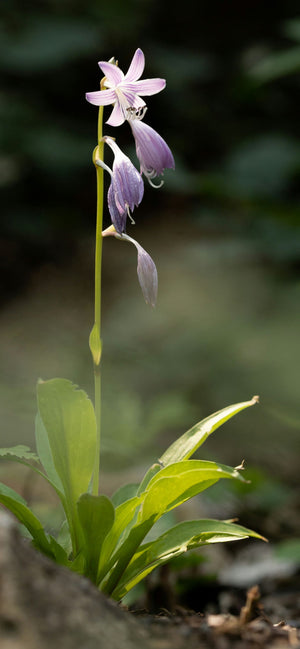
About
Hostas belong to the Asparagaceae family and are native to northeast Asia, including Japan, Korea, and China. They range in size from petite varieties under a foot tall to bold, architectural giants like Hosta 'Sum and Substance' that can span five feet across.
Their foliage, which may be blue, green, chartreuse, gold, or variegated, forms dense mounds and brings reliable texture from spring through fall. Many cultivars also produce lavender or white flowers in mid to late summer on tall scapes, which attract hummingbirds and bees.
A few standout selections include:
- Hosta 'Autumn Frost' – With frosty blue leaves and creamy margins that light up shady corners.
- Hosta 'Guacamole' – Lime-green foliage edged with darker green and lightly fragrant flowers.
- Hosta 'Big Daddy' and Hosta sieboldiana 'Elegans' – Both with thick, blue leaves that add bold texture and slug resistance.
- Hosta 'Curly Fries' and Hosta 'Silly String' – Compact, ribbon-leaf types with narrow, twisty foliage ideal for the front of the border.
- Hosta 'Patriot' and Hosta 'Liberty' – Popular white-edged varieties that brighten dark areas.
- Hosta 'Frances Williams' and Hosta 'Dream Weaver' – Large-leaved blue-green cultivars with showy chartreuse margins.
Whether you’re designing with bold drifts or mixing with ferns and hellebores, hostas are reliable workhorses of the shade garden.
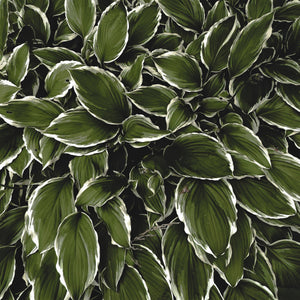
PLANTING
Hostas are easy to grow, and once established, they return year after year with little effort:
- USDA Hardiness Zones: Zones 3–9, depending on cultivar.
- Soil: Moist, well-drained, rich in organic matter. Hostas tolerate a range of soils but thrive in loamy, humus-rich beds.
- Sunlight: Prefer partial to full shade, although golden and variegated types (like Hosta 'Gold Standard' and Hosta 'Velvet Moon') tolerate more morning sun.
- Spacing: Plant 1 to 3 feet apart depending on mature size. Give large varieties like Hosta 'Blue Angel' or 'Great Expectations' ample room to spread.
- Planting Time: Best in early spring or early fall when soil is cool and moist.
Dig a wide hole, spread the roots, and position the crown at or just below soil level. Water deeply and mulch to conserve moisture and suppress weeds.
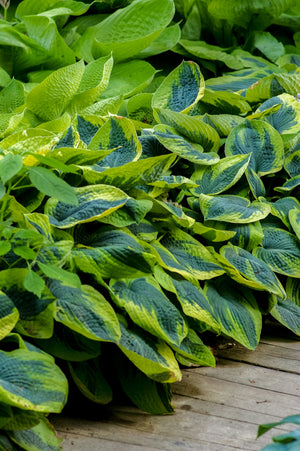
CARE
Once established, hostas require minimal care. However, a few seasonal tasks will ensure vigorous growth and stunning foliage:
- Watering: Water regularly, especially during dry spells. Hostas prefer evenly moist soil but do not tolerate standing water.
- Fertilizing: Feed in spring with a balanced slow-release fertilizer or compost. Avoid late-season nitrogen to prevent tender growth before frost.
- Mulching: Mulch with leaf mold, compost, or shredded bark to retain moisture and regulate temperature.
- Slug & Snail Control: Use traps, diatomaceous earth, or copper tape to protect young foliage, especially in early spring.
- Dividing: Divide every 3–5 years in spring or early fall when clumps become too large or crowded.
- Cleaning: Remove flower scapes after bloom and tidy up old leaves in fall to prevent disease.
Thick-leaved cultivars such as Hosta 'Halcyon' and 'Blue Angel' tend to be more resistant to slug damage than thinner-leaved types.
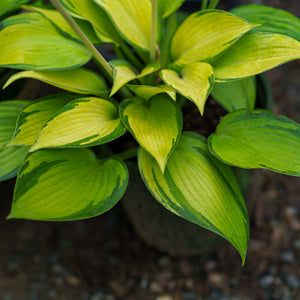
HOW TO USE
Hostas excel as structural and filler plants in shade gardens, complementing both bold and fine-textured companions:
- Mass Plantings: Create dramatic, low-maintenance sweeps with large varieties like 'Sum and Substance' or 'Fortunei Aureomarginata'.
- Mixed Borders: Pair with ferns, brunnera, astilbe, or coral bells (Heuchera 'Fire Chief') for colorful and textural contrast.
- Underplantings: Use under deciduous trees or around the base of hydrangeas for layered interest.
- Containers: Compact varieties like 'Curly Fries' or 'Lakeside Paisley Print' are excellent in shady patio pots.
- Accent Plants: Variegated types like 'Snake Eyes' or 'Seducer' draw attention with bold foliage patterns.
Hostas also pair well with spring bulbs like daffodils, which bloom before the foliage fully emerges, allowing for seasonal layering.
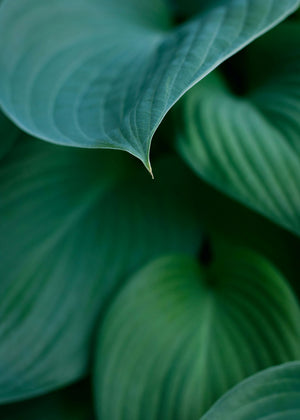
COMMON QUESTIONS
- When to plant hostas? Plant in early spring or early fall when soil is cool and moist.
- How to plant hostas? Dig a wide hole, position the crown at soil level, backfill with rich soil, and water thoroughly.
- Do deer eat hostas? Yes, hostas are highly attractive to deer and often require protection in areas with high deer populations.
- Do rabbits eat hosta? Rabbits may nibble young shoots but are less likely to cause severe damage compared to deer.
- Where to plant hostas sun or shade? Shade is best, though some varieties tolerate morning sun. Afternoon shade is critical in hot climates.
- How far apart to plant hostas? Space 1–3 feet apart depending on mature size.
- Are hosta toxic to dogs? Yes, hostas contain saponins which can cause vomiting, diarrhea, and depression in dogs if ingested.
- Are hosta toxic to cats? Yes, they are toxic to cats and may cause similar digestive symptoms if eaten.
Conclusion
Hostas are timeless perennials that blend practicality with garden elegance. Their wide range of leaf forms, colors, and sizes means there’s a hosta for every shade garden situation. Easy to grow, long-lived, and reliably beautiful from spring to fall, hostas remain one of the most versatile and rewarding foliage plants. With thoughtful variety selection and good care, they’ll thrive and expand year after year.
The Hosta Collection
Sold Out
Sold Out
Sold Out
Sold Out






